A Center Hall Colonial house is a classic American design known for its symmetry and elegance. You'll notice grand entryways with prominent front doors, flanked by double-hung windows that invite natural light. The interior layout features a central hallway, creating a seamless flow between living spaces while offering privacy for upstairs bedrooms. These homes often include traditional elements like fireplaces and spacious front porches, enhancing their charm. With modern adaptations like energy efficiency and smart home technology, they remain popular today. If you're curious about their historical significance and the lifestyle they foster, there's much more to explore.
Key Takeaways
- A Center Hall Colonial house features a symmetrical facade with a central hallway, embodying classic architectural elegance from the 18th century.
- Key characteristics include grand entryways, double-hung windows, and traditional materials like brick and wood siding.
- The interior layout promotes functionality with a central hall, connecting communal areas while providing privacy for upstairs bedrooms.
- Modern adaptations focus on energy efficiency, smart technology, and open-concept designs that enhance usability while preserving traditional charm.
- This architectural style holds strong resale value and is often found in family-friendly neighborhoods, fostering community ties and quality living.
Overview of Center Hall Colonial Design
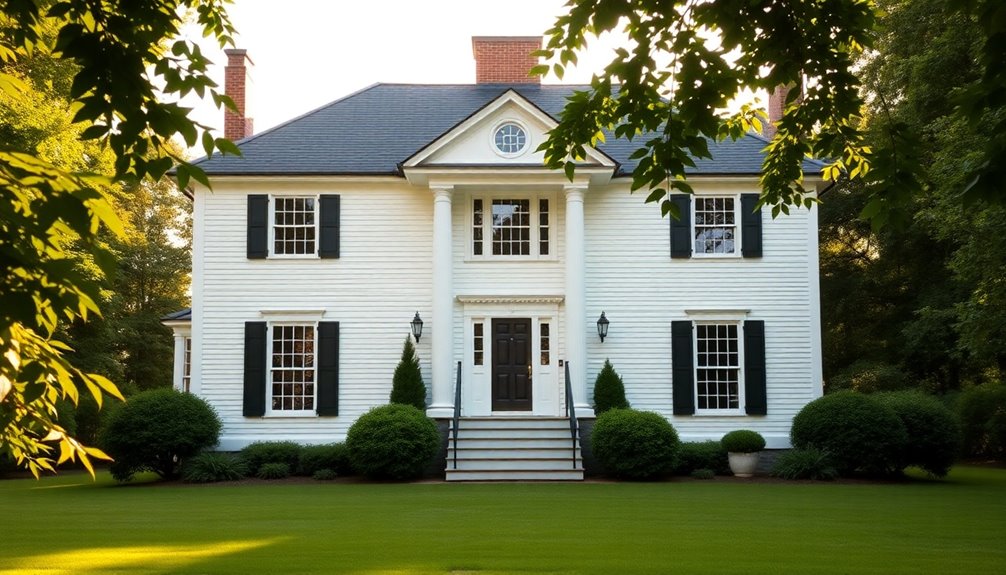
When you step into a Center Hall Colonial, you immediately notice the central hallway that runs through the heart of the home, creating a sense of balance and symmetry.
This architectural style, originating in the 18th century, reflects Georgian and Federal influences, marked by its symmetrical facades and balanced proportions. Typically two stories tall, Center Hall Colonials feature gabled roofs and use traditional materials like brick, wood, and stone.
The layout encourages family interaction, with a grand entryway, large windows for natural light, and central staircases enhancing the flow.
You'll often find living and dining rooms, plus a kitchen on the main floor, while the second floor houses the bedrooms and bathrooms, making it a perfect family home.
Key Architectural Features
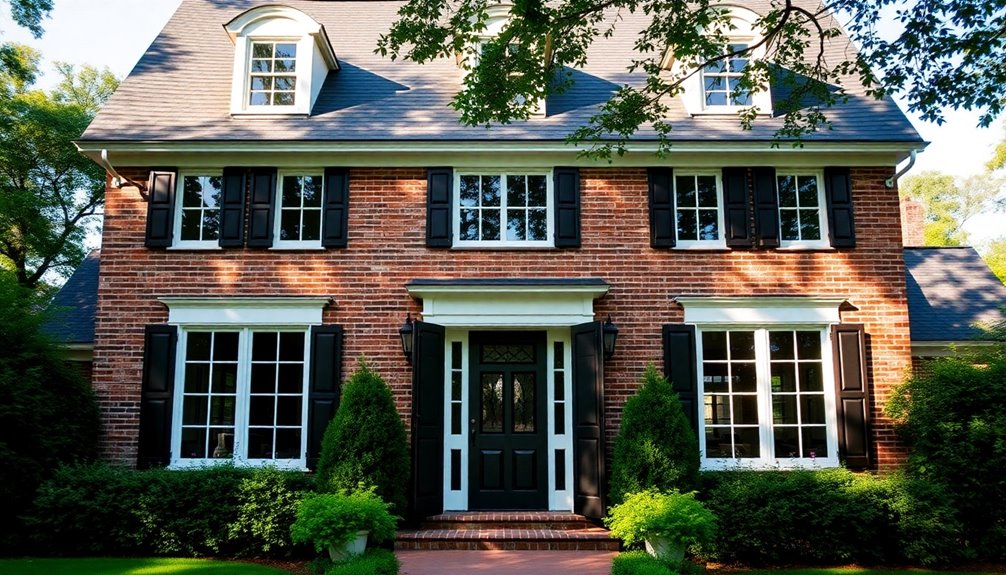
The hallmark of a Center Hall Colonial is its striking symmetrical design, which features a central hallway that runs seamlessly from the front to the back of the home. This layout not only enhances flow but also highlights key architectural features:
- Grand Entryways: Decorative moldings and a prominent central front door create an inviting atmosphere.
- Double-Hung Windows: Large windows flanking the entrance allow natural light to flood the interior, emphasizing the home's elegance.
- Gabled Roof: The distinctive roofline adds to the classic colonial aesthetic, contributing to the home's stately presence.
Common materials like brick and wood siding further enhance the charm, while traditional elements such as fireplaces and spacious front porches complete the quintessential center hall colonial appeal.
Interior Layout and Functionality
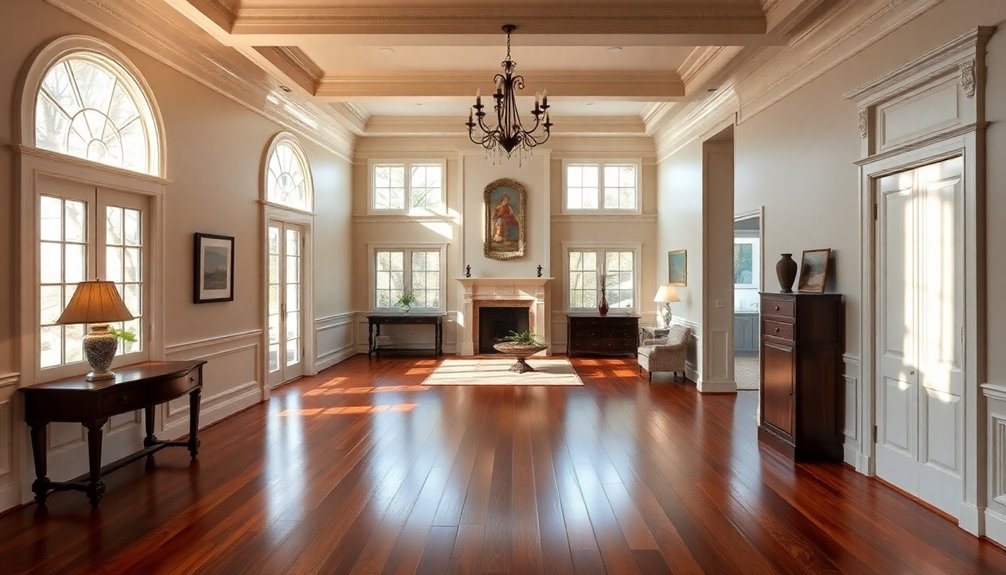
In a Center Hall Colonial, the open floor plan enhances the flow between the living and dining areas, making it perfect for social gatherings.
You'll appreciate how the strategic room arrangement promotes both functionality and flexibility, allowing you to adapt spaces to fit your lifestyle.
With ample natural light streaming in from large windows, the interior feels inviting and spacious, tailored just for you.
Open Floor Plan Benefits
While embracing an open floor plan in a Center Hall Colonial can transform your living experience, it greatly enhances the sense of space and connectivity throughout the home.
This layout connects key living areas, promoting interaction and a communal atmosphere. Here are three key benefits of the open floor plan:
- Seamless Movement: You can easily navigate between the living room, dining room, and kitchen, making everyday activities more fluid.
- Natural Light: Large windows maximize sunlight, creating a bright and airy feel that uplifts the entire space.
- Defined Spaces: Even with an open layout, the central hallway organizes the flow, providing access to both public and private areas, ensuring privacy for bedrooms upstairs. Additionally, the incorporation of natural elements can further enhance the tranquil ambiance of the open design.
Room Arrangement and Flow
An open floor plan not only enhances connectivity but also sets the stage for thoughtful room arrangement and flow in a Center Hall Colonial.
The main floor typically showcases a central hallway, with the living room on one side and the dining room on the other, promoting symmetry and seamless movement. You'll find the kitchen situated towards the rear, providing easy access to both dining areas and outdoor spaces for entertaining.
On the second floor, four bedrooms and multiple bathrooms guarantee privacy while keeping the main living areas distinct.
This layout invites family interaction and social gatherings, with strategically placed windows that flood both public and private spaces with natural light, creating a warm and welcoming atmosphere.
Flexibility for Personalization
Flexibility defines the interior layout of a Center Hall Colonial, allowing you to personalize spaces to fit your lifestyle.
This design promotes easy flow, making it perfect for various needs. You can enjoy the following benefits of flexibility for personalization:
- Room Adaptability: Transform a formal dining room into a home office or playroom as your needs change.
- Privacy Balance: With four bedrooms upstairs, family members can have their own space while communal areas remain vibrant and inviting.
- Modern Touches: Blend traditional charm with contemporary functionality, such as open floor plans and natural light-enhancing windows.
Modern Adaptations and Trends

You'll find that many Center Hall Colonials are now embracing energy efficiency upgrades, making them more sustainable and cost-effective.
The shift towards open-concept layouts not only enhances the flow of space but also modernizes the traditional charm of these homes.
Plus, integrating smart home technology adds convenience and connectivity, catering to the needs of today's homeowners.
Energy Efficiency Upgrades
While preserving the classic charm of a Center Hall Colonial, homeowners are increasingly embracing energy efficiency upgrades to enhance comfort and sustainability.
These upgrades not only modernize your home but also greatly reduce energy costs. Here are three popular options:
- High-Performance Insulation: Improves thermal performance, cutting heating and cooling expenses.
- Energy-Efficient Windows: Double or triple-pane options minimize heat loss, enhancing comfort and aesthetic appeal.
- Solar Panels: Integrate renewable energy sources, offsetting electricity costs and boosting sustainability.
Additionally, consider Energy Star-rated appliances and smart home features like programmable thermostats to further optimize your energy consumption. Incorporating heat pump technology can also significantly enhance the energy efficiency of your home.
Embracing these energy efficiency upgrades guarantees your Center Hall Colonial remains both timeless and eco-friendly.
Open-Concept Layouts
As homeowners seek to blend traditional elegance with modern conveniences, open-concept layouts in Center Hall Colonials have gained popularity.
By removing barriers between key living areas like the kitchen, dining room, and family room, these designs create a seamless flow throughout the main floor. Spacious kitchens often feature large islands that serve multiple functions for cooking, dining, and socializing, enhancing daily living.
The abundance of natural light from large windows and fewer walls fosters a warm, inviting atmosphere. While maintaining classic architectural details such as moldings and hardwood floors, open-concept layouts offer flexibility for personal customization, allowing you to adapt the space to fit your lifestyle.
This modern adaptation retains the charm of the Center Hall Colonial style and can also promote enhanced focus and productivity by minimizing distractions in the home environment.
Smart Home Integration
The modern Center Hall Colonial not only embraces open-concept layouts but also integrates smart home technology to elevate everyday living.
With a central front door that welcomes you, these homes now offer features that enhance comfort and security.
Here are three key smart home integrations:
- Automated Lighting: Control your lights remotely or set schedules for energy efficiency.
- Smart Thermostats: Adjust temperatures effortlessly, saving on utility costs while maintaining that classic charm.
- Security Systems: Monitor your home with smart cameras and alarms, ensuring peace of mind.
Additionally, many homeowners are now considering air purifier technology as part of their home integration for improved indoor air quality.
These innovations blend traditional architecture with contemporary conveniences, appealing to a wide array of buyers in today's real estate market.
You'll enjoy the perfect balance of elegance and modernity in your Center Hall Colonial.
Historical Significance and Cultural Impact
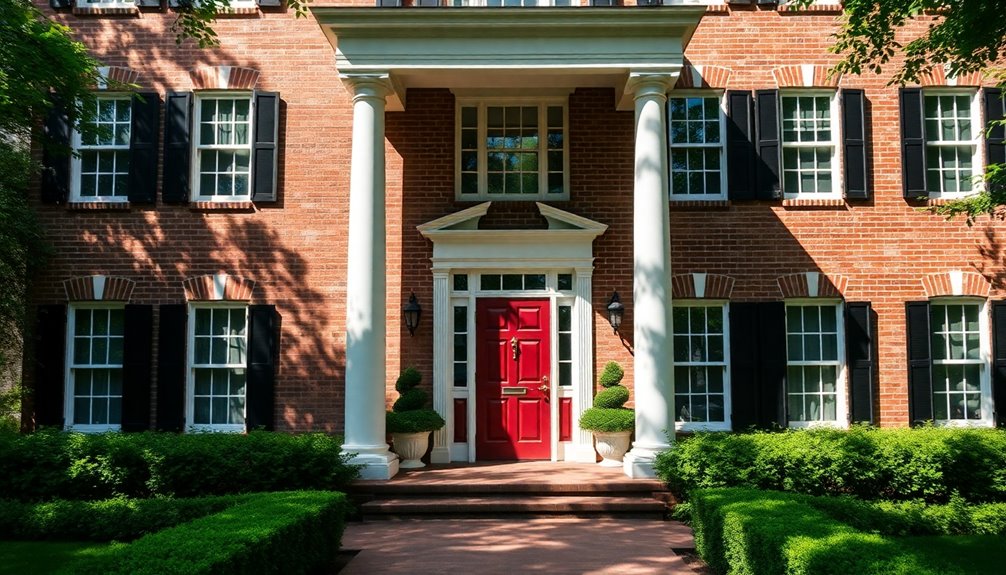
Emerging in the 18th century, the Center Hall Colonial house style reflects a significant chapter in American architectural history, blending Georgian and Federal influences. This style symbolizes affluence and social status, showcasing the prosperity of its early American residents.
As you explore these homes, you'll notice how they've become landmarks, contributing to historical tourism and education. Preservation efforts highlight their importance in American heritage, ensuring that future generations appreciate their significance.
The Center Hall Colonial has also sparked various regional adaptations, blending local climates and cultural elements. Even today, this style inspires modern home designs and renovations, proving its lasting relevance in contemporary architecture and lifestyle.
You'll find that the Center Hall Colonial truly embodies America's architectural evolution.
Variations of Colonial Styles
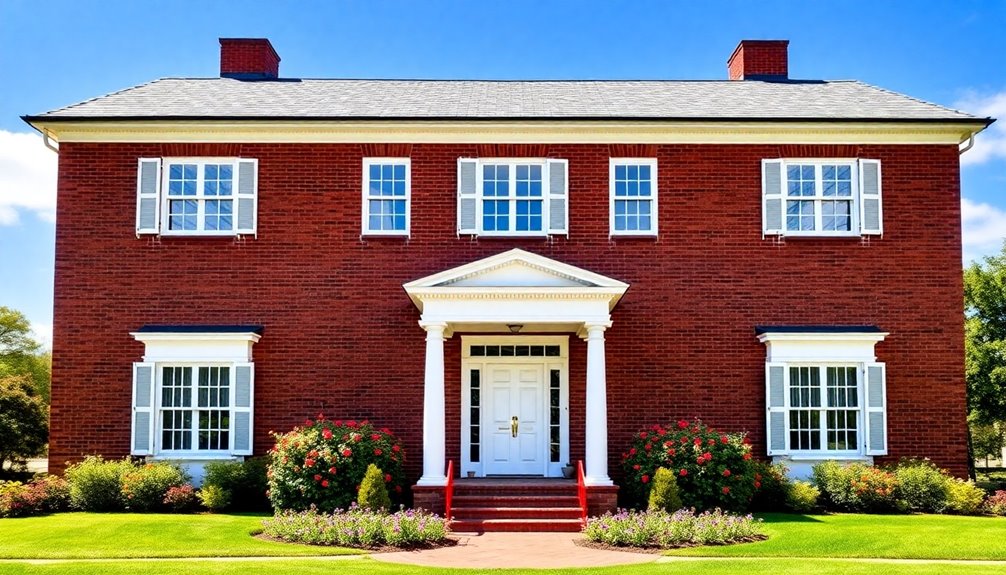
While exploring the diverse world of Colonial architecture, you'll discover a rich array of styles that reflect regional adaptations and historical influences.
Colonial homes aren't limited to the Center Hall Colonial; they encompass various unique designs, each showcasing distinct characteristics:
- Federal Style: Known for its columned entries and gable facades, this style embodies early 19th-century American elegance.
- Saltbox: Recognized by its asymmetrical roofline, the Saltbox diverges from traditional Colonial symmetry, creating a unique profile.
- Garrison Style: This style features a second-floor overhang, offering additional living space and a distinctive aesthetic.
These variations highlight the evolution of Colonial architecture, influenced by local cultures, climates, and available materials, enriching America's architectural history.
Colonial Revival Movement

As you explore the evolution of Colonial architecture, you'll find that the Colonial Revival Movement marks a significant chapter in American design.
Emerging in the early 20th century, especially after World War I, this movement sparked a nostalgic return to colonial roots, drawing inspiration from historic sites like Colonial Williamsburg. It emphasized historical authenticity, which led to the rise of architectural styles like the Center Hall Colonial in suburban developments.
Marketing strategies during this era showcased the charm of Colonial designs, appealing to 19th-century immigrants seeking a connection to American culture.
The Center Hall Colonial became a quintessential choice, offering spaciousness and symmetry that resonated with family-oriented living, ultimately shaping the landscape of American residential architecture.
Enduring Popularity
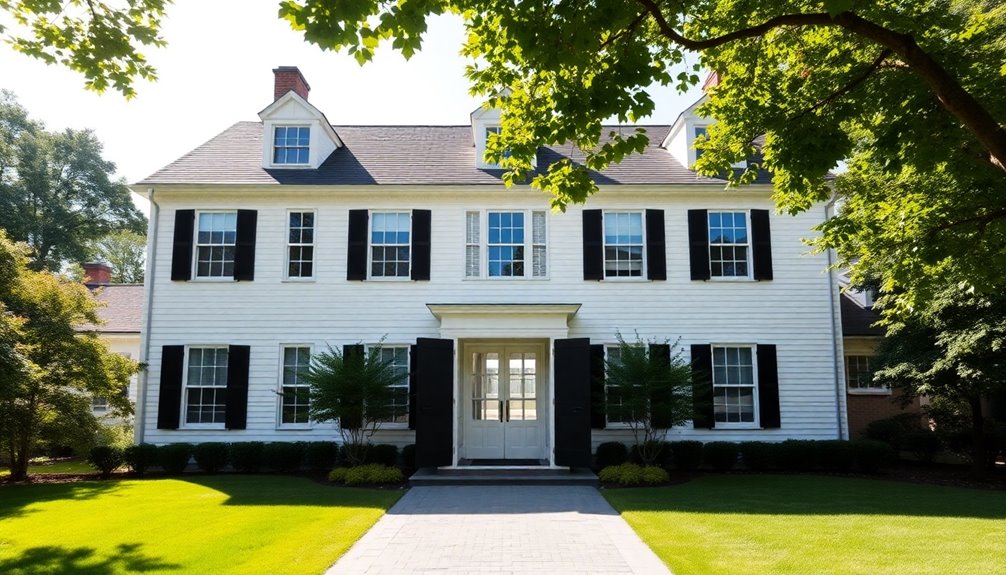
The enduring popularity of the Center Hall Colonial design speaks to its timeless appeal and functionality. This architectural style captures the hearts of homeowners for several reasons:
- Versatile Layout: It accommodates both lively gatherings and peaceful retreats, ideal for modern family living.
- Strong Resale Value: The consistent demand in the housing market reflects its historical significance and practicality.
- Renovation Potential: Many Center Hall Colonials blend traditional charm with contemporary amenities, enhancing their desirability.
You'll often find these homes in family-friendly neighborhoods, fostering a sense of stability and community.
This combination of aesthetic beauty, functional space, and community ties solidifies the enduring popularity of the Center Hall Colonial, making it a cherished choice for generations.
Finding the Right Center Hall Colonial
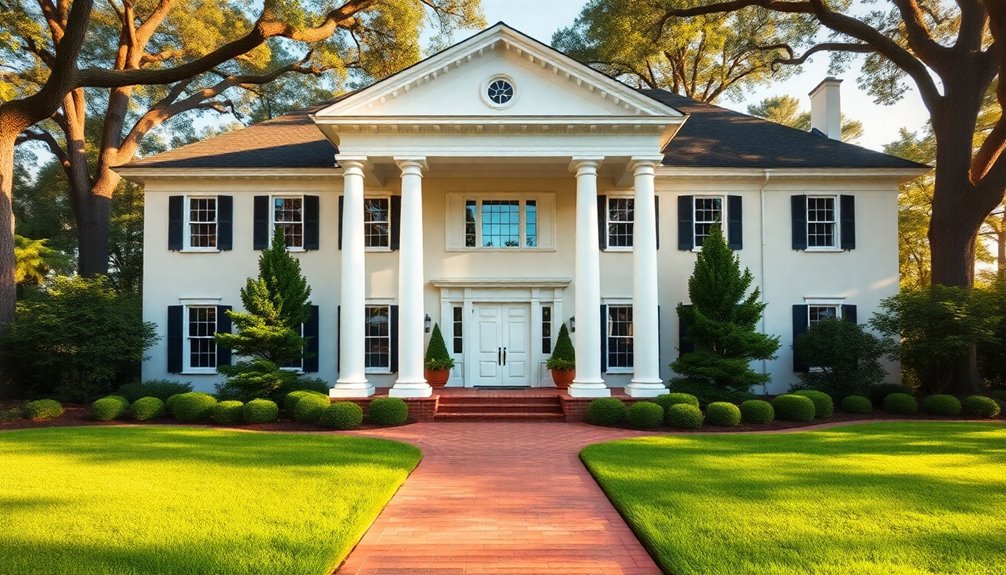
Finding the right Center Hall Colonial can feel like a rewarding journey, especially with so many options reflecting their timeless appeal.
These homes often feature versatile layouts, with a central hallway that connects living and dining rooms, perfect for social gatherings and family life. With four or more bedrooms and 3.5+ bathrooms, you'll find ample space for everyone while ensuring privacy on the upper level.
Many Center Hall Colonials can be customized to fit your personal style, enhancing both interior and exterior features. As you explore listings, consider the range from historic charm to modern renovations, ensuring you find the perfect fit.
Their strong resale value in suburban neighborhoods makes these homes a smart investment for your future.
Community and Lifestyle

While searching for a home, you might find that Center Hall Colonials not only offer appealing architecture but also a vibrant community and lifestyle.
These homes are typically situated in family-friendly neighborhoods, fostering strong social interactions among residents.
Here are a few aspects that enhance your community experience:
- Proximity to Amenities: You'll often find schools, parks, and local shops nearby, making daily life more convenient.
- Outdoor Activities: Many residents enjoy community events and outdoor spaces, promoting engagement and connection.
- Spacious Interiors: The layout encourages family gatherings, enhancing both comfort and community ties.
Additionally, being part of a community can provide access to resources like financial planning that can support your long-term goals.
Living in a Center Hall Colonial means you're not just buying a house; you're joining a welcoming community that values connection and quality of life.
Frequently Asked Questions
What Is a Center Hall Colonial House?
A Center Hall Colonial house is a classic architectural style that features a symmetrical layout with a central hallway running from the front to the back.
You'll notice rooms flanking the hallway on either side, creating a balance that's pleasing to the eye.
Typically, it's two stories tall, with traditional materials like wood or brick.
This design promotes family interaction and functionality, making it a timeless choice for many homeowners today.
What Are the Disadvantages of a Colonial Style House?
Imagine stepping into a time capsule; that's how a colonial-style house feels.
However, you might find some drawbacks. Maintenance costs can add up, as traditional materials need constant care. The formal design often limits how you use the space, making it less adaptable for modern living.
Plus, if you're in a suburban area, commuting can be a hassle, and those stairs can pose challenges for anyone with mobility issues.
What Does a Classic Colonial House Look Like?
A classic Colonial house features a symmetrical facade with a central front door and evenly spaced windows that create a balanced look.
You'll notice two stories topped with a gabled roof, often made from traditional materials like brick or wood siding.
Inside, a central hallway connects the living and dining rooms, enhancing flow.
Architectural details like decorative moldings, large windows, and inviting front porches add to its timeless charm and classic appeal.
What Makes a House a Colonial House?
When you think of a Colonial house, picture symmetry and charm side by side.
It's defined by its central entrance, rectangular shape, and gabled roof, creating a classic silhouette. You'll notice tall, double-hung windows that let in natural light, along with a central hallway connecting the main spaces.
Whether it's Federal, Garrison, or Saltbox style, each variation reflects history and regional flair, making your Colonial home a timeless treasure.
Conclusion
To sum up, the Center Hall Colonial house remains a beloved symbol of American architecture. Did you know that nearly 20% of homes built in the U.S. before 1950 embraced this classic design? This enduring popularity speaks to its timeless appeal and functionality, blending history with modern living. Whether you're drawn to its symmetry or its spacious interiors, a Center Hall Colonial can truly enhance your lifestyle, offering both elegance and comfort for generations to come.









